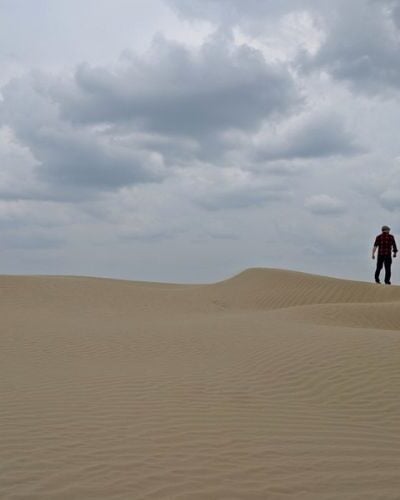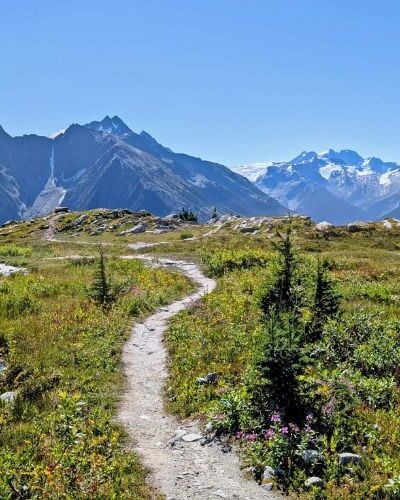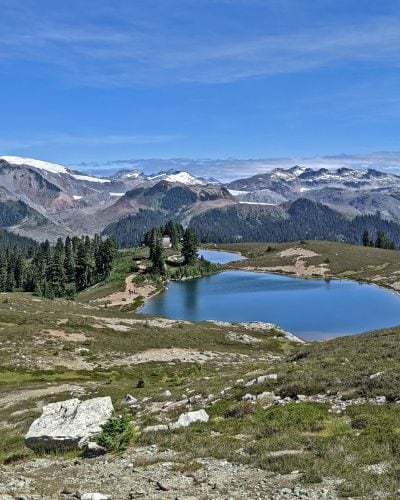Ready to discover a hidden corner of Québec with endless boreal forest, rolling hills, peaceful lakes, star-filled skies, long summer days, approachable small cities, all with a hint of French Canadian charm? Let me introduce you to Abitibi in Western Québec.
We visited Abitibi for the first time this past summer, as part of a road trip from Montréal to Toronto via Rouyn-Noranda (the long way round!) The expansive scenery and solitude left the biggest impression on us.

Two large protected areas – Aiguebelle National Park and La Vérendrye Wildlife Reserve – highlight the region’s natural diversity and range of outdoor experiences on offer.
We spent almost a week exploring hiking trails, paddling the lakes and appreciating the wild beauty of the boreal forest and Abitibi itself.
This guide shares all the essentials for planning a nature-filled trip to the uncrowded Abitibi region of Québec, with a focus on Aiguebelle National Park and La Vérendrye Wildlife Reserve.
In partnership with Tourisme Abitibi-Témiscamingue. There are affiliate links below. If you click and make a purchase, we may receive a percentage of the sale.

Abitibi, Québec
Abitibi is a vast, predominantly rural area of Western Québec. Its largest centers are Rouyn-Noranda (42k population) and Val-d’Or (32k).
The word Abitibi is Algonquin for ‘place where the waters divide,‘ a reference to the Arctic/Atlantic watershed divide that occurs in this area. I’ll explain more about that later.

The Anicinabe (Algonquin/Anishinaabe) peoples have lived here for thousands of years, long before fur traders and missionaries started to arrive in the 17th century.
European settlement advanced when the National Transcontinental Railway was constructed in the early 20th century and then further driven by the Québec government during the Great Depression in the 1930s.

Abitibi represents a significant part of the Abitibi-Témiscamingue region. The hyphen matters – it links the two areas, yet also highlights their differences.
Their striking contrasts come from very different geological histories.
The landscape of Abitibi reflects the rugged Canadian Shield with dense boreal forest, mostly shallow lakes and rolling terrain, while the more compact Témiscamingue is a blend of forested hills, valleys and vast lakes. Both areas have agricultural land to the northwest.
Aiguebelle National Park
Aiguebelle National Park (Parc national d’Aiguebelle) is Abitibi’s premier destination for outdoor adventure. I’d recommend spending one or two nights here, more if you want to be truly immersed in nature and have time to truly relax.
This Sépaq operated park highlights three key features – Abitibi’s signature clay plains, the forested Kinojévis Hills and fascinating geological formations, including volcanic rocks and fault lakes.

The latter is particularly unique, since one of the lakes (Lac La Haie) marks the boundary for the Arctic and Atlantic watershed divide. In other words, all rivers north of Lac La Haie flow to the Arctic Bay (Hudson Bay) and all southern rivers flow to the Atlantic (St Lawrence River).
Beyond its striking landscapes, Aiguebelle supports plenty of wildlife, from moose, beavers, and foxes to wolves, black bears and numerous bird species.
The park is pretty quiet and relatively undeveloped beyond the southern area, which helps the animals thrive.
Visiting in early September 2025, we found the park to be exceptionally well staffed and maintained, though it is disappointing that some of the biggest attractions are currently closed due to recently updated health and safety regulations.

Best activities in Aiguebelle National Park
Aiguebelle is most well known for its 22m high Passerelle Suspendue (Suspension Bridge) over Lac La Haie.
The bridge is part of the 3.5km Traverse hiking loop, which climbs up and down along the shoreline of the lake, with short detours to see some cool geological formations and a waterfall at the southern end. The views from the bridge are fabulous and well worth the trip.

The Traverse can be hiked as part of a longer circuit, L’Aventurier (9.5km). It’s both more difficult and a much longer time commitment – plan for 4.5 to 6 hours. A highlight of the route are the tall cliffs on the northeastern side.
An easier way to reach the cliffs is to rent a canoe and paddle Lac La Haie to the Ruisseau des Ours picnic area and then join the trail from here. This took us about 2.5 hours from start to finish. Seeing the lake from both perspectives was definitely worthwhile! We were the only paddlers on the lake.

We also hiked L’Escalade (short, sometimes steep route to a viewpoint), Le Garde-Feu (quick hike to an old fire tower with great views) and La Castorière (family friendly boardwalk around a lake, chance to see beavers). Due to stormy weather, we weren’t able to climb Mont-Dominant, one of Abitibi’s tallest peaks at 572m.
Sadly, it is not possible to go up le Garde-Feu at this time due to the aforementioned health and safety issues. Likewise, the park’s other signature hike, Les Paysages, is also closed for the foreseeable future. It featured an amazing spiral staircase ascending a rock face.

Where to stay in Aiguebelle National Park
The park has three campgrounds and a range of ready-to-camp tents, cabins and shelters. The latter make it easy for travellers without a lot of camping equipment to fully enjoy the park, all while sleeping on a ‘proper’ bed rather than on the ground!
For facilities, my top pick are the Étoile ready-to-camp tents. We stayed in one of these at Opémican National Park in Témiscamingue and loved how well equipped they were – all cooking equipment, a kettle, toaster, utensils and even wine glasses. Campers only need to bring bedding, food and drinks.

As for the cabins, the Collembole one on Lac du Moulin looked incredible. Super private, exclusive access to the lake, full kitchen, indoor bathroom and a canoe rental all included. There is running water but is not suitable for drinking.
We stayed at les Racines du p’tit Isidore, less than a kilometre from the park’s southern entrance. Set on more than 500 acres, this family-run retreat features four handcrafted cabins.
We stayed in one of the A-frame cabins, complete with a wood stove, loft sleeping area, outdoor shower, and a deck overlooking the stunning Kinojévis River. A wonderful place to be based to explore Aiguebelle National Park!

La Vérendrye Wildlife Reserve
Réserve faunique La Vérendrye is one of Québec’s largest protected areas, spanning over 4000 lakes and 12,589 square kilometres of land. Its northern section lies in Abitibi, while the southern part stretches into Outaouais.
This is classic Canadian Shield country, with boreal forest, tiny intricate lakes and rocky outcrops. The lakes are full of lake trout, northern pike and walleye, while the forests are home to moose, black bear, grouse and many other animals.

With so many lakes, it is easy to understand why the reserve is one of the best places to go canoeing in Québec. There are 500 backcountry campsites and many possibilities of circuits ranging from overnight trips to two week expeditions.
While still operated by Sépaq, it is important to note that La Vérendrye is a wildlife reserve rather than a park. This means that fishing and hunting are some of the most popular recreational activities alongside canoeing.

Best activities in La Vérendrye
For us, canoeing is the number one reason to visit La Vérendrye. A multi-day trip is the way to go if you can, but we enjoyed our 20km day paddle on Lac Grand and Lac Nichcotéa. The lakes have a lot of interesting features, with plenty of bays for shelter from the wind.
We visited half a dozen campgrounds along the way and they seemed very well placed and exceptionally clean. Facilities are pretty basic, with just a barrel toilet only.

Reservations are required for multi-day canoe trips in La Vérendrye – this is available by phone only at this time (1-844-897‑4980). Reserving a site means that you have exclusive use of it, so no sharing required.
The Domaine canoe camping registration centre is situated on the Outaouais side of the reserve. Canoe rentals are available, as well as shuttles to other locations in the reserve.
The most popular activity in La Vérendrye in the summer months is fishing. It’s easy to understand why, with walleye, northern pike and lake trout being plentiful. JR and I are not great anglers but both managed to catch some good sized pike!
Please note that there is a fishing access fee on top of the daily admission fee.

Where to stay in La Vérendrye
We spent four days in La Vérendrye in early September, staying in one of the Giroux cabins near the Nichcotéa campground. Located right on the Abitibi/Outaouais border, the cabins are 25km from Highway 117 along an unpaved but well maintained road.
The Giroux cabins are a dream for such a relatively remote location – two bedrooms, each with bunk beds, plus a full kitchen, dining area, wood stove and bathroom.

The only thing missing is electricity and bedding (bring your own). Designed primarily for anglers, each cabin has exclusive use of a private boat on a shared wharf. There is an extra fee for the motor.
All this and the cabins have a lot of privacy too. We could only see the light of our neighbour’s campfire late at night. Otherwise, we were completely alone with the dark skies and stars. An effortless way to experience the outdoors!

Other things to do in Abitibi
Close to Rouyn-Noranda, we enjoyed exploring the Kékéko Hills. There’s a sprawling hiking trail network with many possibilities for loops and out-and-back treks.
The landscape is a blend of taiga-type forest, lakes and cliffs. A highlight is the nid de l’épervier (‘nest of the hawk’), a multi-level viewpoint with far reaching panoramas.
We hiked a beautiful 7km loop including the hawk’s nest and Lac Despériers. It’s competely free to hike in the Kékéko Hills and dogs are permitted (almost everyone seemed to have one!)

Val-d’Or and Rouyn-Noranda are the largest communities in Abitibi. As the name implies (‘Valley of Gold,’) Val-d’Or was founded after a gold rush and mining continues to be an important local industry. It’s possible to travel 90m underground and visit one of the mines, la Cité de l’Or.
Continuing the theme is la microbrasserie Le Prospecteur, a Val-d’Or craft brewery with some really creative brews. We found their beers in shops and gas stations across the region – my favourite was the Cousine Japonaise with yuzu. There is a taproom in downtown Val-d’Or.

Rouyn-Noranda is also known for mining, specifically copper smelting, but it has a more artsy cultural vibe. There are more than a dozen galleries and museums in this small city.
There’s a big summer festival too – the Festival de musique émergente (FME). We were originally planning to go but due to an airline labour strike, we missed it. Featuring more than 100+ artists, it sounds incredible – I hope we have another chance to go one day.

Abitbi trip planning
Keep the following travel tips in mind when planning your trip to Abitibi, Québec!
When to go
The main tourism season for Abitibi is late June to late August, during the warm summer season.
Outside of this time, the weather is likely to be cooler and some restaurants, tours and attractions will be closed. On the other hand, a lot of places will be even quieter!
The autumn colours start arriving in early/mid September, depending on the year.

How to get to Abitibi
There are two main driving routes to access Abitibi – which you choose depends on where you are travelling from and your destination. Abitibi-Témiscamingue is a big region!
From most places in Québec, the quickest route is Highway 117 from Montréal. It takes around 4 hours 20 minutes to reach the southeastern boundary of Abitibi (380km). The drive is straightforward and travels alongside the Laurentian Mountains.

Based in Gatineau? You have a choice! Either take Highway 105 then the 117 OR enter Abitibi from the western side, via Ontario (Highway 101). Rouyn-Noranda is a six hour drive either way.
The easiest entry point for Ontario visitors is via Témiscamingue, near North Bay. From Toronto, Rouyn-Noranda is a seven hour drive.
Rouyn-Noranda has an airport with Air Canada Express flights to Montréal.

Visiting Témiscamingue
If you have the time, I’d recommend visiting Témiscamingue as well as Abitibi. For travellers from Ontario, it’s also convenient as you’ll be driving through Témiscamingue on your way to Abitibi!
Témiscamingue is tucked against the Ontario border, with beautiful Lake Timiskaming and the Ottawa River forming the boundary. One of the largest towns, Témiscaming, is just a one hour drive from North Bay by road. Toronto is 4.5 hours away.
The compact size of Témiscamingue and mix of lakes, forest, farmland, waterfalls and rivers make it a pleasure to explore. Opémican National Park is a highlight and is also one of Québec’s ‘newest’ national parks. It has a host of excellent hiking trails as well as an interesting historical background.
Have a read of our full guide to Témiscamingue – you’ll soon see why it’s worth adding a few days to your Abitibi adventure to check it out!

Travel tips
- Be prepared to lose phone signal in some areas. In La Vérendrye Wildlife Reserve, for example, phone signal is very limited. It’s a great excuse to switch off and relax! Before leaving, be sure to tell someone where you’re going and when you plan to be back
- Bring bug repellent. While we didn’t have any issues with mosquitoes and blackflies in early September, I have heard that they can be nasty earlier in the summer. Bring your favourite repellent and other items (like a head net) as needed, especially when camping
- Remember to pay the park fees for Aiguebelle. Québec’s national parks have daily access fees. It’s possible to pay online or at the gate
- National parks = provincial parks in Québec. Just to avoid confusion, Québec’s national parks are provincially operated/funded and are not part of the federal network adminstered by Parks Canada
- Most of the roads within La Vérendrye wildlife reserve are unpaved. The ones we drove were in decent condition but still expect to drive 50-60km/h as standard and watch for potholes
- Pick up groceries in Val-d’Or and/or Rouyn-Noranda. These towns have the best choice of shops and supplies
- Have some French ready. While we found that a lot of people working in local tourism spoke English, it is polite to know at least the basics. Hello (bonjour), thank you (merci) and please (s’il vous plait) will be welcomed!
- Remember to Leave No Trace to help keep Abitibi beautiful! Stay on hiking paths, pack out everything you bring (including trash), leash dogs and clean up after them, don’t bring anything natural home with you

More Québec posts you may find helpful
Discover the Mingan Archipelago, Québec: National Park Travel Guide
The Best Things to Do in Témiscamingue, Québec: Opémican National Park & Beyond
Québec’s Whale Route: Highway 138 Road Trip Guide
Ultimate Two Week Coastal Quebec Road Trip Itinerary
Magdalen Islands Travel Guide: The Best Things to Do, See & Eat
10 Fast and Fun Gaspé Peninsula Hiking Trails, Québec
Four Fun Ways to Go Whale Watching in Tadoussac, Quebec
The Best Places to Camp on the Gaspé Peninsula
Check out these recently published posts:

One half of the Canadian/British couple behind Off Track Travel, Gemma is happiest when hiking on the trail or planning the next big travel adventure. JR and Gemma are currently based in the beautiful Okanagan Valley, British Columbia, Canada. Consider buying us a coffee if you have find any of our guides helpful!




